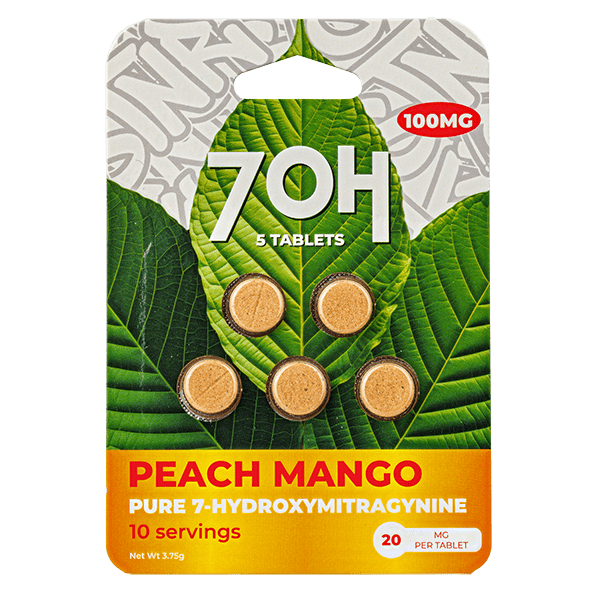The fascinating world of brain chemistry takes an interesting turn when we examine 7-hydroxymitragynine (7-OH), a compound that’s attracting the attention of scientists worldwide. This powerful natural substance found in kratom has remarkable effects on the brain’s neural pathways. Let’s explore how this compound works and why it matters for potential medical uses.
OH Mitragynine and Its Impact on the Brain
OH Mitragynine?
7-hydroxymitragynine (7-OH) is a fascinating natural compound formed when our body processes mitragynine, the main active ingredient in kratom. What makes it special? Well, it’s about 13 times more powerful than morphine in interacting with the brain.
Here’s how it works: When mitragynine enters your body, your liver transforms it using special enzymes called cytochrome P450 3A isoforms. This creates 7-OH, which then strongly attaches to specific receptors in your brain called mu-opioid receptors.
Hydroxymitragynine in Kratom
While kratom doesn’t contain much 7-OH naturally, this small amount packs quite a punch. In fact, 7-OH is about five times stronger than regular mitragynine when taken orally.
Think of it like this: mitragynine and 7-OH work together in a perfect natural balance. Even though there’s more mitragynine in the plant, when your body converts it to 7-OH, that’s when many of kratom’s effects really kick in. It’s a great example of how our bodies can enhance natural plant compounds.
OH Affects Brain Function
When we look at how 7-OH works in the brain, it’s pretty impressive. It interacts with multiple brain systems – dopamine, serotonin, and adrenergic receptors, creating a complex web of effects that makes it unique.
What’s really interesting is how it interacts with mu-opioid receptors. 7-OH works as what scientists call a G protein-biased agonist. In simpler terms, this means it might offer benefits while causing fewer side effects than similar compounds, especially when it comes to breathing problems.
Here’s something surprising: taking more 7-OH doesn’t always mean stronger positive effects. In fact, higher doses can actually make the experience unpleasant – it’s like the compound has its own built-in safety switch.
When it comes to side effects, we need to be careful. While 7-OH shows promise, it’s powerful stuff. Since it affects multiple brain systems at once, different people might react differently to it.
Potential Therapeutic Benefits and Concerns
Looking at 7-OH compared to morphine reveals some interesting possibilities. Studies show it can help with pain while potentially causing milder withdrawal symptoms, especially when used as part of the whole kratom plant.
There’s an important difference between natural kratom and isolated 7-OH products. Pure extracts might be more likely to cause dependency because they’re more concentrated and don’t have the other balancing compounds found in the whole plant.
When it comes to safety, the numbers are reassuring but shouldn’t make us careless. The median lethal dose (LD50) is between 106 mg/kg and 1,606 mg/kg – way above what people typically use. Still, it’s crucial to use it responsibly and keep monitoring its effects.
7-OH might help people dealing with opioid withdrawal and tolerance issues, offering a potential alternative approach. However, we need to balance this potential with concerns about dependency, especially with concentrated forms. Scientists are still working on finding the best ways to use the benefits while minimizing risks.
Regulatory Perspectives and Legal Status
The rules around this legal herb keep changing as we learn more about kratom and its compounds. Different places have different rules, which affects both research and availability.
Hydroxymitragynine Regulations Worldwide
Around the world, rules about 7-OH vary quite a bit. In the US, while kratom isn’t banned federally, states make their own choices. Some have banned it completely, while others have passed the Kratom Consumer Protection Act to make sure products are safe and high-quality.
European countries handle it differently too. Places like Denmark, Poland, and Sweden have strict controls, while other countries are more relaxed about it. In Asia, especially where kratom grows naturally, many countries balance traditional use with modern safety rules. Thailand’s recent change from banning to regulating kratom shows how views can shift with new research.
The big challenge for regulators is finding the sweet spot between keeping people safe and allowing access to potential benefits. Many are now pushing for better testing and quality control instead of outright bans.
Conclusion & Looking Forward
As scientists continue their research, we’re learning more about how 7-OH interacts with our brains, uncovering both exciting possibilities and important safety considerations.
OH Affects the Brain
The way 7-OH works with brain chemistry is truly fascinating. It’s unique in how it affects multiple brain systems while working differently from traditional compounds, suggesting it might have useful medical applications we haven’t fully explored yet.
From pain relief to mood effects, 7-OH’s impact on brain chemistry shows we need to keep studying it carefully. Future research will likely focus on getting the most benefit while reducing any risks.
We’re at an exciting point where scientific discoveries could lead to practical medical uses. As we develop better ways to use 7-OH’s properties, careful research and evidence-based approaches will be key to making sure it’s both safe and effective.
Understanding how 7-OH affects the brain is an ongoing journey that could change how we approach certain medical challenges. Moving forward, we’ll need to balance its promising benefits with proper safety measures.










